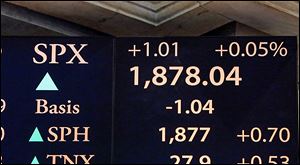
WALL STREET
Despite many obstacles, bull market run turns 5
3/10/2014
The current bull run is not the longest or strongest in history, but it has survived a near default by the U.S. government, a debt crisis in Europe, and a war in Syria.
NEW YORK — Happy 5th birthday, bull market.
The current bull run is not the longest or strongest in history, but it has survived a near default by the U.S. government, a debt crisis in Europe, and a war in Syria.
Despite all the obstacles thrown in its way, this bull market is now the fourth-longest since 1945, according to S&P Capital IQ.
The Standard & Poor’s 500 index is up 178 percent in the five years since it bottomed out on March 9, 2009.
Its advance has been driven by massive stimulus from the Federal Reserve, a drawdown in debt, and a rebound in corporate profits.
The S&P 500 ended Friday at a record high at 1,878.04. Over the same time span, the Dow Jones Industrial Average has gained more than 150 percent while the Nasdaq has rocketed more than 240 percent.
A bull market is a rise of 20 percent or more over a period of at least six months, following a decline of 20 percent or more.
The current bull had a tough start in 2014.
In January, the Standard & Poor’s 500 index fell 3.6 percent on concerns about slowing growth in China and other emerging markets. Investors also worried about the strength of the U.S. economy.
This month the market has been rattled by events in Ukraine, where the region of Crimea is preparing for a referendum on whether to split away and join Russia. President Obama and other Western leaders have condemned the referendum.
Despite the latest setbacks, stocks recovered and the S&P 500 index closed at a record high of 1,878.04 on Friday.
There have been 11 bull markets since 1945.
The longest one stretched for almost a decade, between October, 1990, and March, 2000. The average bull market lasts 4½ years.
Typically, bull markets end when investors get spooked by a recession, or anticipate one, and sell stocks.
None of that is happening, which suggests this bull may have room to run yet.
The economy appears to be strengthening rather than faltering. Corporate profits are at record levels. The job market is gradually improving and consumer confidence is rising. Inflation also remains low.
Stock valuations remain in line with historical averages, said John Manley, chief equity strategist at Wells Fargo Fund Management. The price-earnings ratio for the next 12 months, which measures stock prices compared with forecast earnings, stands at 15.5, slightly below its 20-year average of 16.4.
The bull market’s gain is above the average advance of 141 percent for S&P 500 bulls. But it is well short of the 417 percent jump from the 1990s run.
Since starting its advance in March, 2009, the S&P 500 has handed investors a total return, including reinvested dividends, of 209 percent.
If you’d played it safe and invested in bonds, your total return would be 28 percent over the same period, according to the Barclays U.S. aggregate index.
The best-performing stocks in the S&P 500 index during the bull market are a drugmaker, a hotel company, and a broadcaster.
Regeneron Pharmaceuticals, which is developing an experimental asthma drug, has climbed from $12.40 in March, 2009, to $328.11 on Friday.
Wyndham Worldwide, a hotel and lodging company that owns the Ramada and Days Inn, has soared from $3.10 to $75.70 as demand for hotels revives.
CBS has climbed from $3.09 to $67.40 as advertising revenue increased.
Among stocks still in the S&P 500 index since the start of the bull market, the worst performers are a solar panel maker, a mining company, and a supplier of wholesale electric power.
First Solar’s shares are down from $108.36 to $56.11, a drop of 48 percent. The company has struggled to adapt to sharply lower panel prices.
Newmont Mining has dropped from $37.79 to $24.60, hurt by falling gold and copper prices.
Exelon, the nation’s largest supplier of wholesale electric power, has dropped from $43.84 to $29.82 as electricity prices have fallen.